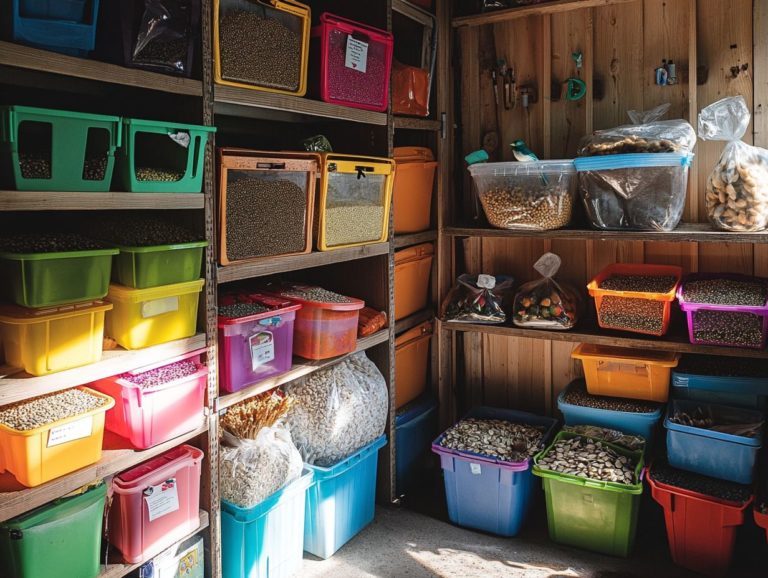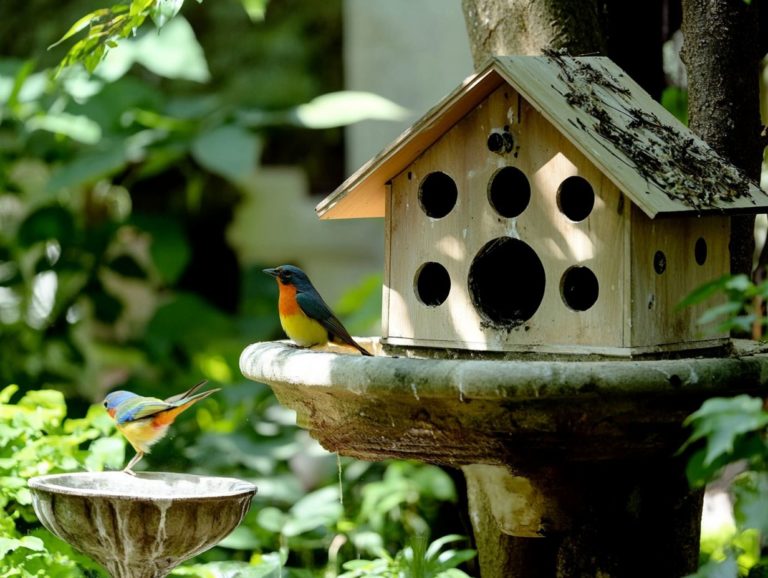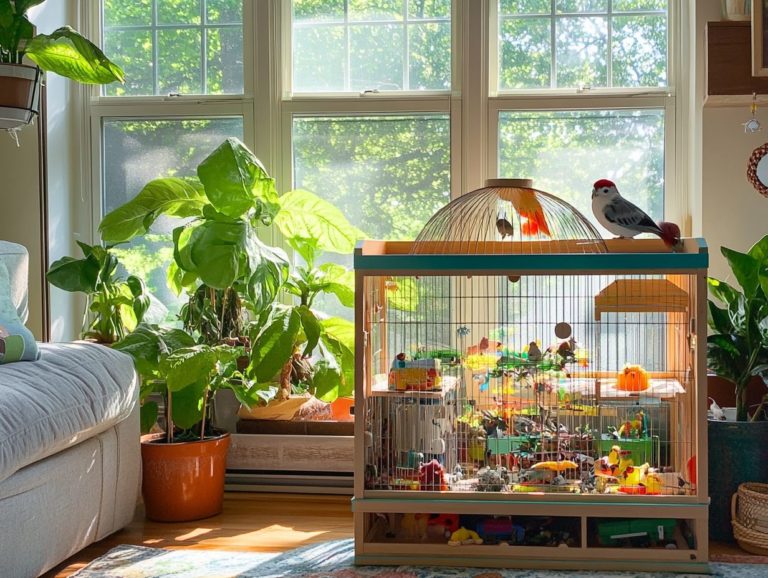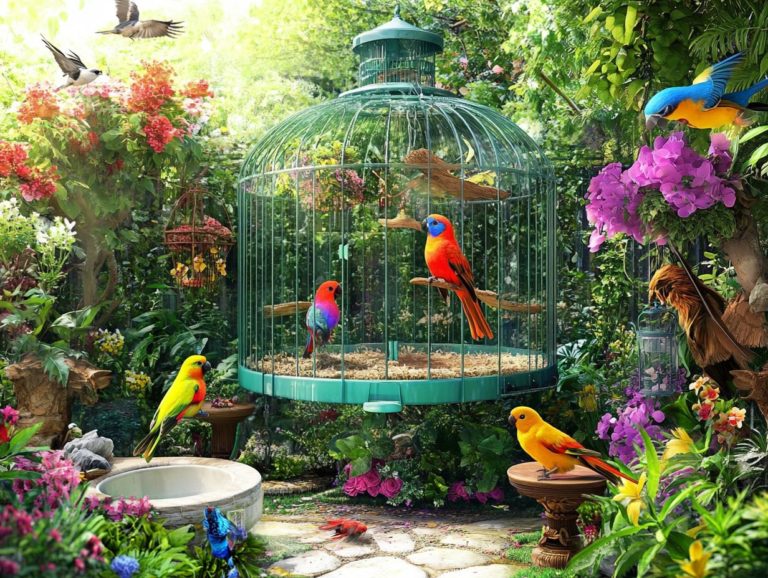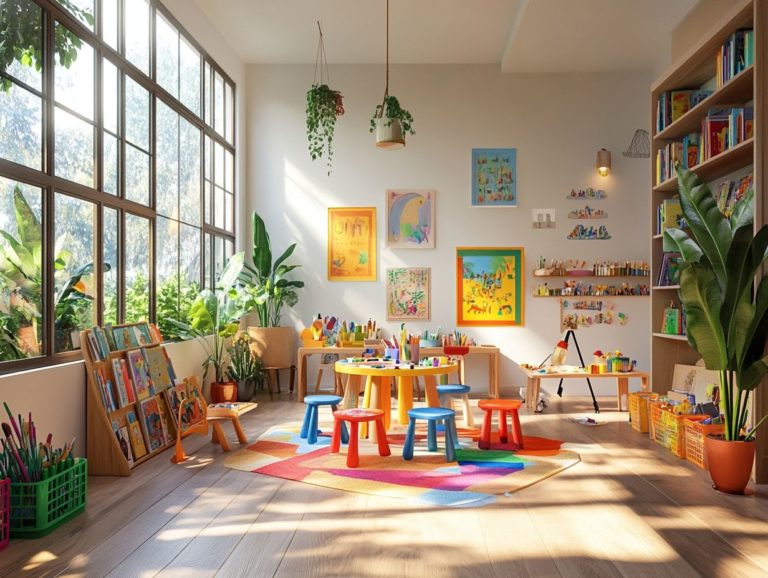Choosing the Right Cage for Budgies
When you want to create a happy and healthy environment for your budgies, choosing the right cage is essential.
With many options like wire cages and large aviaries understanding the different types can greatly affect your birds’ well-being.
This guide discusses key factors to consider, including size, materials, and accessibility. It will also highlight common mistakes to avoid.
Your budgies deserve the best. It all starts with the perfect cage!
Contents
- Key Takeaways:
- Types of Cages
- Factors to Consider When Choosing a Cage
- Setting Up the Cage
- Common Mistakes to Avoid
- Frequently Asked Questions
- 1. What factors should I consider when choosing the right cage for my budgies?
- 2. What size cage do budgies need?
- 3. Is it better to get a cage with horizontal or vertical bars for my budgies?
- 4. Are there any specific features that I should look for in a budgie cage?
- 5. Can I use a birdcage for my budgies?
- 6. How often should I clean my budgie’s cage?
Key Takeaways:
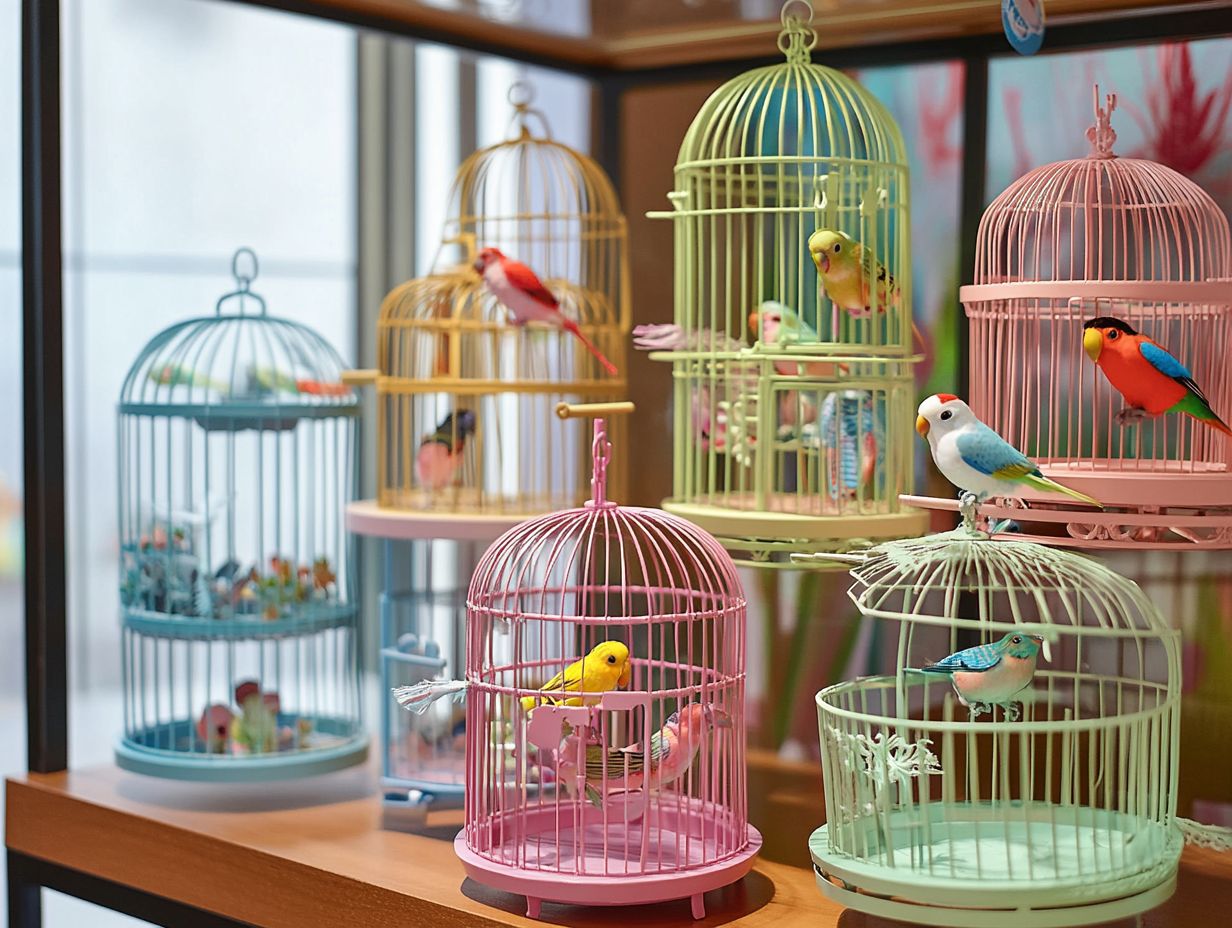
Why a Proper Cage is Important for Budgies
A well-designed cage is vital for your budgies, as it creates a comfortable home that prioritizes their well-being. There are several factors to consider when choosing a cage.
This setup allows them to move freely in a safe space, which is crucial for their health.
With spacious cages that meet minimum size and height requirements, your feathered friends can thrive and enjoy an enriched life. It s important to know the right requirements, like the distance between bars, especially if you’re welcoming a budgie or enhancing their home.
Choosing the right cage isn’t just about size; it s also about using safe, non-toxic materials. Cages that are too small or made from harmful materials can cause stress or illness.
Horizontal bar spacing helps your budgies climb, which is key for their physical health. Including perches, toys, and feeding stations promotes mental stimulation and activity, ensuring they stay happy and healthy.
Types of Cages
When considering the best home for your budgies, it’s essential to understand how to choose the right cage for your species and the different types of cages available.
Options include indoor cages, outdoor cages, flight cages, wire cages, and aviaries. Each type offers unique benefits that affect your birds’ comfort and behavior.
By assessing these types, you can create a spacious environment tailored to your budgies needs, keeping them both happy and healthy.
Wire Cages
Wire cages are a top choice among bird owners. They are durable and provide excellent ventilation, which is critical for your feathered friends’ comfort.
These cages enhance airflow and offer playful budgies ample space to roam and engage in natural behaviors. The distance between bars should be narrow enough to prevent escapes but wide enough for comfortable movement.
When setting up, arrange toys, perches, and food bowls at different heights to promote exercise and mental stimulation. Keeping the cage clean is crucial for ensuring a healthy environment for these vibrant birds.
Flight Cages
Flight cages are crafted to provide your budgies with a spacious environment where they can exercise and engage in natural behaviors. These elements are crucial for their well-being and happiness.
Unlike standard cages that confine movement, flight cages offer a lot of space. Here, your birds can stretch their wings, fly freely, and explore their surroundings, simulating their natural habitat. This increased freedom fosters both physical health and mental stimulation.
These cages are designed with both vertical and horizontal space to allow climbing and flying. They inspire your budgies to engage in instinctual activities like flapping their wings and socializing. The layout typically includes perches, toys, and various enrichment features tailored to their needs, ensuring that these vibrant creatures are not just comfortable but truly thriving.
Aviaries
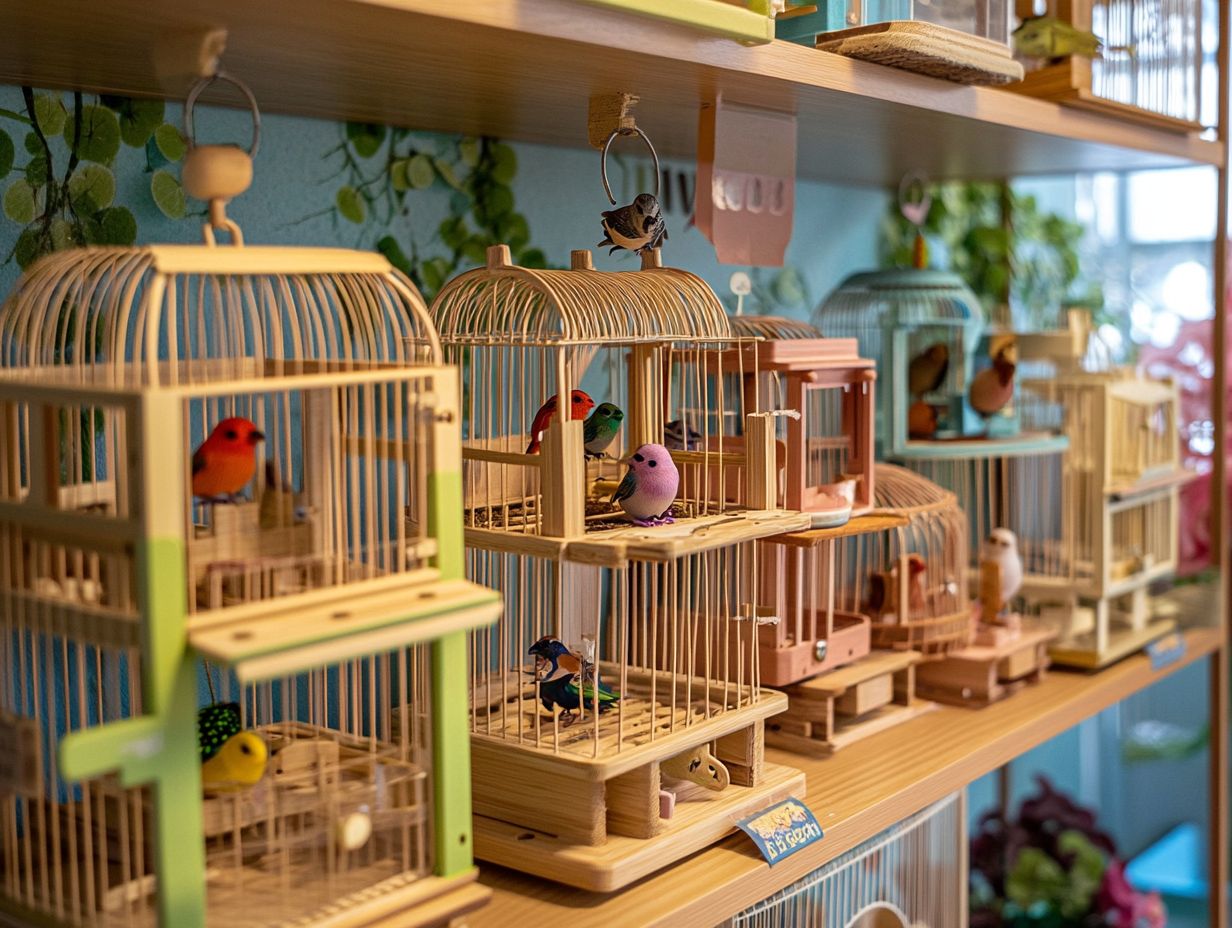
Aviaries provide a spacious and enriching environment for your budgies, allowing them to socialize, fly, and explore. This is an ideal choice for anyone seeking to create a truly expansive bird habitat.
In these roomy retreats, your budgies thrive on communal living. This nurtures their natural instincts to interact in a safe, stimulating atmosphere. The generous space encourages healthier physical activity, allowing for flights and playful antics, while significantly reducing boredom and stress often found in smaller cages.
When designing an aviary for outdoor use, incorporate features like shaded resting areas, perches at varying heights, and natural plants. These create a vibrant ecosystem that invites exploration. Such thoughtful arrangements enhance the well-being of your birds and provide a visual feast for you, creating a harmonious balance between nature and companionship.
Factors to Consider When Choosing a Cage
Choosing the ideal cage for your budgie involves careful consideration of essential factors that prioritize both comfort and safety, as outlined in our guide on choosing the right habitat for budgerigars.
Pay attention to cage specifications, including size, materials, and ease of access for effective cleaning and maintenance. For more insights on providing the ideal environment for your pet, check out this guide on how to choose a bird cage with a stand. Give your budgie the perfect home where they can feel safe and happy!
Size and Space Requirements
Understanding the size and space requirements for budgie cages is essential for creating a comfortable home that allows these charming creatures to thrive. Choosing the best lightweight cages for birds can ultimately enhance their happiness and allow them to express their natural behaviors.
When choosing a cage, consider the specific dimensions for various budgie sizes and activity levels. For instance, a minimum cage width of 24 inches is often recommended for a pair of budgies, giving them enough space to stretch their wings and engage in playful interactions. Additionally, refer to this guide on how to choose the right location for a cage; height is another crucial factor, as taller cages provide multiple perches at different levels, encouraging climbing and exploration.
Spacious cages are essential for active birds, allowing them to fly short distances, which promotes their well-being. Overcrowding can lead to significant stress and behavioral issues, such as feather plucking and aggression. Therefore, ensuring adequate space is key to fostering a happy and healthy environment for your feathered friends.
Materials and Durability
Selecting the right materials for your budgie cage is crucial for ensuring safety, longevity, and ease of maintenance. Additionally, choosing the right swing for your bird significantly impacts both the durability of the cage and your bird’s overall well-being.
Different materials have varying levels of resilience and hygiene. For instance, stainless steel is a popular choice due to its strength, rust resistance, and easy cleaning, making it a safe haven for your active budgies.
Avoid cages made from untreated wood or plastic, as these materials can harbor bacteria tiny germs that can make your bird sick and suffer from wear and tear. Regular cleaning with bird-safe solutions, along with frequent replacement of perches and toys, will help maintain a sanitary environment for your feathered friend.
Understanding your material choices not only enhances the quality of the cage but also positively contributes to your pet’s health and happiness.
Accessibility and Cleaning
Accessibility and ease of cleaning are crucial for maintaining your budgie’s habitat. A well-designed cage makes maintenance easier, allowing both you and your feathered friends to thrive in a healthy living environment.
A thoughtfully designed cage dramatically improves your ability to manage regular maintenance tasks, such as changing food and water or cleaning up droppings. Cages with removable trays, spacious doors, and strategically placed perches provide hassle-free access, making it easier to prioritize cleanliness in your routine.
A clean and safe habitat supports your birds’ physical well-being and nurtures their mental health.
By regularly wiping down surfaces with bird-safe cleaners and keeping fresh bedding, you create a sparkling environment that fosters happiness. These simple yet effective practices ensure that your budgies flourish in a safe space where they can play and socialize. Accessibility is vital in their care.
Setting Up the Cage
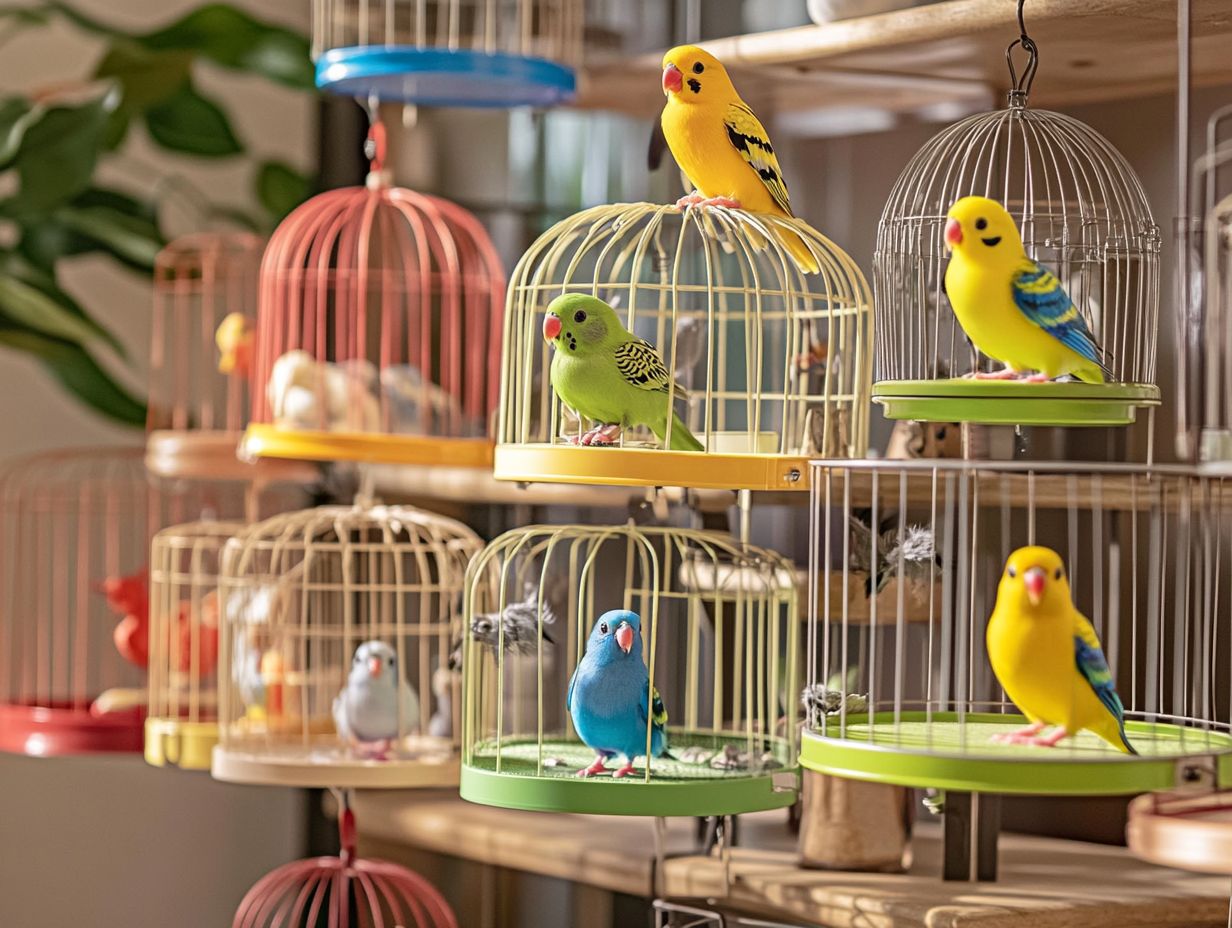
Setting up your budgie’s cage requires careful planning, particularly regarding placement, essential accessories, and thoughtful arrangements. This ensures that the cage meets your bird’s needs and fosters a stimulating and enriching environment.
Essential Accessories and Perches
Essential accessories, such as wooden perches, toys, and food cups, enhance the comfort and well-being of your budgie. These items aren t just for show; they re vital for promoting the physical and mental health of these vibrant birds.
Perches should vary in size and texture to encourage natural foot exercises and prevent boredom. Incorporating materials like rope and cement provides a range of gripping experiences.
A diverse selection of toys from fun tasks to chewable delights can significantly boost your budgie s mental engagement, keeping it active and entertained. Well-designed food cups tailored to their feeding habits ensure easier access to nutritious food, greatly contributing to their overall vitality.
Location and Placement
The placement of your budgie’s cage is crucial for ensuring both comfort and safety. This significantly influences their overall well-being.
Choosing the right location involves several important factors. Consider how much natural light the area receives; budgies thrive in bright, indirect sunlight that mirrors their natural habitat. It’s equally vital to maintain a stable temperature as they prefer a warm environment free from sudden drafts or extreme cold. Don t overlook noise levels; a quieter area helps minimize stress, allowing your bird to feel secure.
Act quickly to consider these elements to enhance your budgie’s happiness and longevity.
Common Mistakes to Avoid
Avoiding common mistakes when setting up your budgie’s cage is essential for their health and happiness. Errors can lead to overcrowding, insufficient space, and exposure to unsafe materials, impacting your feathered friend s well-being.
Taking the time to create a safe and spacious environment will ensure your budgie thrives and enjoys a fulfilling life.
Overcrowding and Inadequate Space
Overcrowding and inadequate space in budgie cages can lead to significant stress and behavioral issues. Carefully assess your cage requirements.
When too many birds are crammed into a small area, their natural instincts as social creatures become stifled. This can result in stress-related behaviors such as feather plucking, nonstop squawking, or even aggressive interactions among themselves. Limited space restricts their ability to engage in vital activities like flying, climbing, and exploring essential for their mental and physical well-being.
By providing a spacious cage, you allow for greater movement and exploration, ultimately fostering a happier and healthier environment for your delightful little companions.
Unsafe Materials and Accessories
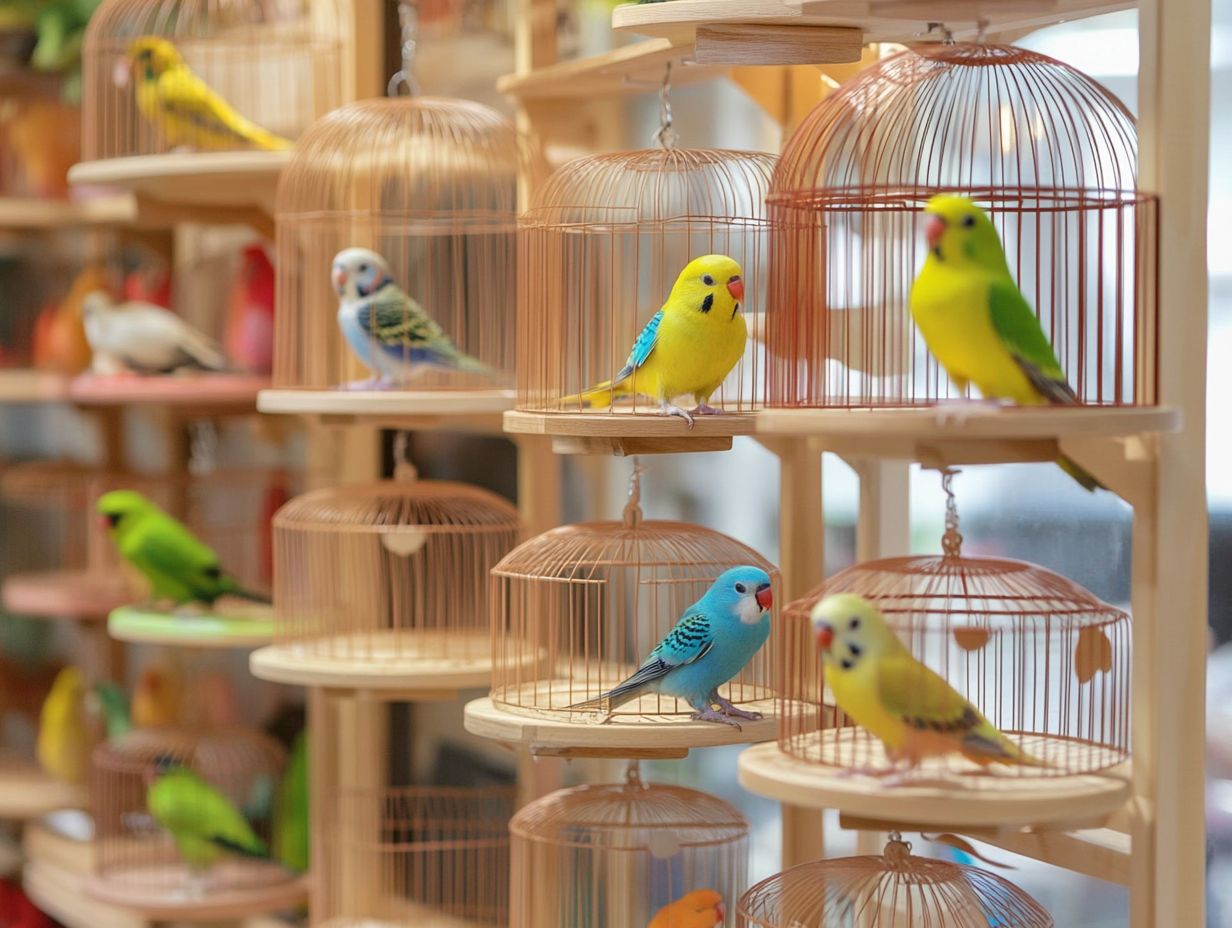
Using unsafe materials and accessories in your budgie’s cage can put their health and safety at risk. It’s crucial to choose wisely when creating a home for your feathered companion.
Birds are incredibly sensitive creatures, and poor material choices can lead to serious health issues. Here are some items you should avoid:
- Untreated wood, which may harbor harmful chemicals.
- Certain types of plastics that can leach toxins.
For metal accessories, opt for bird-safe materials like stainless steel. Other metals might rust or corrode, posing a risk of ingestion.
Regular cleaning helps maintain a safe environment. Clean the cage using pet-safe detergents and ensure that any toys or accessories are thoroughly vetted for safety.
Prioritizing your pet’s safety when selecting accessories plays a vital role in the overall health and happiness of these delicate birds. Your budgies deserve the best! Start by choosing the right materials that ensure their safety.
Check out this video for more tips on budgie care!
Frequently Asked Questions
1. What factors should I consider when choosing the right cage for my budgies?
When choosing a cage for your budgies, consider the size, material, and design. The cage should be spacious enough for your budgies to move around and fly, made of safe and durable materials, and designed for easy cleaning and maintenance. For more detailed guidance, check out this article on choosing the right cage for your bird.
2. What size cage do budgies need?
The cage should be at least 20 inches in length, 18 inches in width, and 18 inches in height for 2 budgies. If you have more than 2 budgies, the cage should be larger and provide enough space for each bird to have their own territory.
3. Is it better to get a cage with horizontal or vertical bars for my budgies?
Budgies are active birds and love to climb, so a cage with horizontal bars is more suitable. Vertical bars can hinder their movement and may not provide enough space for them to exercise and play.
4. Are there any specific features that I should look for in a budgie cage?
One important feature to consider is a removable bottom tray for easy cleaning. Other features such as perches, food and water dishes, and a swing can make the cage more comfortable and stimulating for your budgies.
5. Can I use a birdcage for my budgies?
While it may be tempting to use a birdcage for your budgies, it’s not recommended. Birdcages are often too small and have vertical bars that can be harmful. Instead, it’s best to invest in a cage specifically designed for budgies, along with the perfect bird cage accessories.
6. How often should I clean my budgie’s cage?
It’s important to clean your budgie’s cage at least once a week, or more frequently if needed. Remove droppings, food debris, and old bedding, and thoroughly clean and disinfect the cage and all accessories. This will help keep your budgies healthy and happy.

